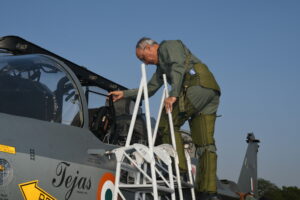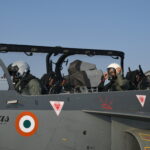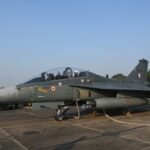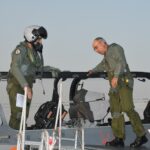
Republic Day Parade was well covered by India Today.
Had an interesting chat with Shiv Aroor.
Talked about the following:-
- Importance of Awards and Recognition.
- Women in Armed forces.
- IAF and self-reliance.
Please click on the link below:-
Contents of IAF press release on the occasion of Republic Day:-
INDIAN AIR FORCE PARTICIPATION IN
REPUBLIC DAY 2024

- Homage Ceremony at National War Memorial. The Republic Day Celebrations will commence with the homage ceremony at the National War Memorial, where the Hon’ble Prime Minister will lay a wreath to pay homage to those who laid down their lives in service of the Nation. An Inter-Services Guard, comprising of one Officer and 21 Inner guards (seven from each service) and six buglers (two from each service) will be in attendance. The Inner guards from the IAF would include one Sergeant and six Corporals and below. The inter-services guards will present arms with a “Salami Shastra”, followed by “Shok Shastra”. Simultaneously, the buglers will sound the “Last Post”. Thereafter, a two-minute silence will be observed. This will be followed by the Guards again presenting a “Salami Shastra” with the buglers sounding a “Rouse”.
- IAF Marching Contingent. The Republic Day Parade starts after the flag hoisting ceremony at ‘Kartavya Path’. The IAF marching contingent will be led by Squadron Leader Rashmi Thakur with Squadron Leader Sumita Yadav. Squadron Leader Pratiti Ahluwalia and Flight Lieutenant Kirti Rohil as supernumerary Officers. The Air Force Contingent will be marching abreast in a 12 by 12 formation to the tune ‘Sound Barrier’ played by 72 IAF musicians and three drum majors. The band will be led by Sergeant CA Daniel.
- Tri-Services Marching Contingent (AGV Women). In addition to the IAF Marching Contingent, a tri-services contingent of Agniveervayu (Women) will be participating in the Republic Day Parade 2024. A total of 48 Agniveervayu Women would be part of this contingent. Flight Lieutenant Shrishti Verma would be marching as supernumerary Officer of the contingent.
- Beating Retreat. The Beating Retreat ceremony will be carried out at Vijay Chowk. The IAF Band, comprising 121 musicians will be participating in the event. The band will be led by Warrant Officer Ashok Kumar.
- IAF Tableau. The theme of the 75th Republic Day Parade-2024 is “Samridh Bharat Sashakt Bharat”. Accordingly, the theme of the IAF tableau is “Bharatiya Vayu Sena: Saksham, Sashakt, Atmanirbhar”. This translates to “Indian Air Force: Potent, Powerful and Self-Reliant”. Flight Lieutenant Ananya Sharma and Flying Officer Asma Sheikh, both Su-30 pilots, would be present on the tableau. The tableau will have the following elements depicting these aspects of the IAF:-
(a) Rear Element: ‘Saksham’. The IAF has been at the forefront of rendering humanitarian aid, both within and across borders. Operation Kaveri was launched on 24 Apr 23 to evacuate Indian nationals from Sudan, which was witnessing internal strife at the time. The IAF’s C-130J aircraft were used extensively towards rescuing 3,862 Indians from the country. The rear element of the tableau depicts one specific sortie of this mission during which an IAF C-130 extricated Indian nationals from Wadi Sayyidna in Sudan under extremely adverse conditions at night.
(b) Middle Element: ‘Sashakt’. The IAF Tejas and SU 30 flying over the IOR depict the ever-expanding reach of the IAF- over land, as well as over the sea. Such long range operations required the exploitation of the space domain for myriad reasons. Because of the possibilities that the space domain offers, it is getting increasingly enmeshed in the IAF’s peacetime and wartime functioning. The GSAT- 7A positioned on the tableau represents the IAF’s incorporation of space technology in its operations. The IAF’s gender inclusive approach to its functioning is reflected by the two women aircrew in full flying gear.
(c) Front Element: ‘AtmaNirbhar’. This element depicts an IAF C-295 transport aircraft being flown by two women aircrew in the cockpit. The C-295 is a transport aircraft that has recently been inducted into the IAF and will be manufactured in India. The presence of IAF Garuds also signifies the enhancement of IAF’s combat capability- both in air, as well as on ground. At the vertical portion of the front element, the new IAF Ensign is shown which reflects the current values of the IAF by inclusion of the IAF Crest in the top right corner of the Ensign. The IAF Crest has the national emblem, the Ashoka lions on the top, with the words in Devanagari below it. Below the Ashoka lions is a Himalayan Eagle with its wings spread, enclosed by a ring in light blue colour with the words, “भारतीय वायु सेना”. The motto of the IAF “नभः स्पृशं दीप्तम्” is inscribed below the Himalayan Eagle in Devanagari.
- Fly Past. A total of 51 IAF aircraft comprising 29 fighter aircraft, eight transport aircraft, 13 helicopters and one heritage aircraft will participate in this year’s Republic Day flypast. Four aircraft from Indian Army and one from Indian Navy will also fly in two separate formations with the IAF aircraft. All these aircraft will operate from six different bases. The participating aircraft will fly in several formations, the details of which are as follows:-
(a) Dhwaj Formation. ‘Dhwaj’ formation comprising of four Mi-17 IV helicopters will be flying in an ‘Inverted Wineglass’ formation, trooping the National Ensign, as well as those of the three services. Helicopters of the formation will shower flower petals on the audience.
(b) Rudra Formation. The ‘Rudra’ formation would comprise helicopters from the Army Aviation Corps and would include one LCH Prachand and three ALH WSI helicopters flying in a four-aircraft ‘Diamond’ formation.
(c) Baaz Formation. Three MiG-29 aircraft will fly past in a ‘Vic’ formation.
(d) Prachand Formation. Prachand formation would have an LCH Prachand helicopter in lead, with two each Apache and ALH MK-IV aircraft together flying in a five aircraft ‘Arrow’ formation.
(e) Tangail Formation. Tangail formation, comprising of one Dakota aircraft in lead, with two Dornier aircraft in echelon, will fly in ‘Vic’ formation.
(f) Arjan Formation. A C-295 aircraft flanked by two C-130 aircraft in echelon, will fly as the Arjan formation.
(g) Netra Formation. Netra formation, comprising of one AEW&C aircraft and two Su-30 aircraft in echelon, will fly in ‘Vic’ Formation.
(j) Varuna Formation. An Indian Navy P-81, flanked by two IAF Su-30 aircraft will fly as the Varuna formation.
(k) Bheem Formation. Bheem formation comprising of a C-17 and two Su-30 aircraft in echelon (streaming fuel) will flypast in ‘Vic’ formation.
(1) Tejas Formation. Making its debut in the Republic Day Parade, will be the Tejas formation, comprising four Tejas aircraft in ‘Diamond’ formation.
(m) Amrit Formation. Amrit formation will comprise six Jaguar aircraft in an ‘Arrow- head’ formation.
(n) Vajraang Formation. Vajraang formation, comprising of six Rafale aircraft, will fly in ‘Inverted Wineglass’ formation.
(0) Trishul Formation. Trishul Formation, comprising of three Su-30 aircraft, will fly in ‘Vic’ Formation.
(p) Vijay Formation. The Fly-past will culminate with a show stopper manoeuvre of the Vijay Formation, comprising of a Rafale aircraft.
Suggestions and value additions are most welcome
For regular updates, please register here:-
References and credits
To all the online sites and channels.
Disclaimer:
Information and data included in the blog are for educational & non-commercial purposes only and have been carefully adapted, excerpted, or edited from sources deemed reliable and accurate. All copyrighted material belongs to respective owners and is provided only for purposes of wider dissemination.






